Friday 10th
Journée - région - Pay du Lauragais
One of the very popular features at Toulouse les Orgues are the day trips out into the surrounding countryside organised, of course, around organs and organ builders. We joined the visit to the Lauragais, an area to the east of Toulouse. From the mid-fifteenth to the mid-sixteenth century, enormous prosperity came to Toulouse and the Lauragais from the production of woad (pastel). The small towns and villages still bear witness to these riches in terms of their architecture.
The tour took in four organs of eighteenth century date, of which three were played - St Félix de Lauragais, Mirepoix and the Cathedral at Pamiers. The fourth, at St Papoul, lies forlorn and abandoned in a former monastery which for 400 years was a cathedral. It is hard to reconcile this with the sleepy little village that is St Papoul today. I plan a more detailed account of the organs at St Félix and Mirepoix in a further issue, hopefully as part of a series of occasional articles on the organs of the Languedoc.
St Félix
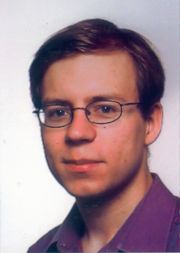 The village of St Félix de Lauragais stands on a hilltop and is very picturesque. Birthplace of the composer Déodat-de Severac (1872 - 1921), it has a beautiful wooden market hall standing in a square of timber-frame houses. The gothic style church is tucked away among the buildings of the main street.
The village of St Félix de Lauragais stands on a hilltop and is very picturesque. Birthplace of the composer Déodat-de Severac (1872 - 1921), it has a beautiful wooden market hall standing in a square of timber-frame houses. The gothic style church is tucked away among the buildings of the main street.
The concerts away from the main programme each have a local input and local colour. At St Félix, under the disapproving glare of four teachers, some forty primary school children were tolerably quiet during an hour's programme designed by the organist Nicolas Loth (pictured) to demonstrate the sounds of this Rabiny instrument (1779 - 1781) which had been restored in 1996. This he did effectively although without any verbal descriptions or other guidance which would have been helpful. He played: Toccata septima by Georg Muffat (1653 - 1704); two voluntaries by Henry Purcell (1659 - 1695), one in D minor written for the "double organ"; and a Magnificat by Michel Corrette (1709 - 1795).
Some of the 'French' tones - particularly those of older instruments - sound strange and harsh to English ears when first heard. I was surprised, however, to see some of the young local schoolchildren sniggering each time a Cromorne or Cornet solo was played on this instrument. They will get used to such sounds as the years go by, I have no doubt!
Mirepoix
Mirepoix is a little-known gem just south of the Lauragais. The central square is almost entirely surrounded by broad, timbered arcades above which rise pastel-coloured timber frame buildings. In another square to one side lies the former cathedral of Saint-Maurice. The single nave of the church is immensely wide - the widest of any Gothic church in France.
The organ was built by the German firm, Link, in 1891. Its physical appearance matches the nave, being spread out over the vast width of the west wall. Because of this, it appears as though there is virtually no depth to the organ although overall it has a pleasing, relatively plain, appearance and nicely frames a small rose window. The organist has his or her back to the instrument which caused me to wonder whether the extra mechanical linkages may make the action particularly heavy. The recitalist, Stéphane Bois told me afterwards - with some emphasis - that the action was indeed very heavy especially, of course, when manuals were coupled.
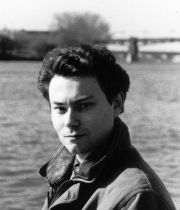 Since it is a German organ, Stéphane Bois (pictured) chose to play Mendelssohn and Reger. The registration used for the first work, Mendelssohn's fourth sonata, sounded very familiar (and non-French) to my ears. After the Mendelssohn, Mr Bois played four pieces by Max Reger, opus 69: Moment musical no. 4, Capriccio, no.5, Romance no.8 and Toccata and fugue no. 7. The registration seemed somewhat dull to me and the pedals hard work.
Since it is a German organ, Stéphane Bois (pictured) chose to play Mendelssohn and Reger. The registration used for the first work, Mendelssohn's fourth sonata, sounded very familiar (and non-French) to my ears. After the Mendelssohn, Mr Bois played four pieces by Max Reger, opus 69: Moment musical no. 4, Capriccio, no.5, Romance no.8 and Toccata and fugue no. 7. The registration seemed somewhat dull to me and the pedals hard work.
The organ has recently been cleaned and given a new blower. It seemed as though the entire population of Mirepoix had assembled to hear, for the first time, the pristine instrument. The church was overfull and some people had to stand. The proceedings were enlivened by the audience's reaction to this treat. Their enthusiasm could not be contained and - unlike the sophisticated audiences in Toulouse who wait until the end of the whole concert to give their applause - every movement of every piece was applauded and sometime also the pauses while the organist changed the registration! Add to this a baby crying, enthusiastic talking during the playing and much coming and going and I felt relieved for the recitalist's sake that he could not see the circus going on down below. Jean-Jacques Germain, the Festival President, remarked dryly afterwards that it was 'very lively'!
Apparently there are plans to restore this organ which fortunately has not suffered any modifications since it was built in 1891. The action can now be heard in soft passages but this is not intrusive (unlike the baby!). The tones of the soft stops are pleasing and we heard rich, well-modulated tones with no unwelcome harshness in the louder passages. I hope to revisit this organ at some future date and prepare an article for publication in the magazine.
Pamiers
From Mirepoix we went to Pamiers Cathedral for the final recital of the day at 9.00 pm. The Cathedral of St Antonin is another huge brick edifice with an octagonal bell tower. The recital was co-produced with the Fauré Festival, Gabriel Fauré being a celebrated son of that town. The gloomy nave was packed. The programme had advertised a recital by the highly respected Marie-Claire Alain but to everyone's dismay she had fallen and broken a leg when leaving "La Maison de la Radio" in Paris some days before. In the event Olivier Latry deputised and with one exception performed Marie-Claire Alain's programme; thus we had a second opportunity to hear Mr Latry play, and this time playing a very different programme on a different organ.
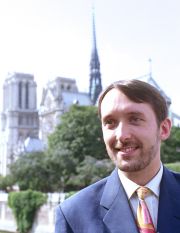 Warning bells clang whenever someone says 'To be honest with you' and I experienced similar misgivings when the announcer said 'There are a lot of musicologists here and I won't bore you ...' Well, half an hour later we heard the first notes from the organ, Olivier Latry (pictured left) setting off at a cracking good pace, obviously determined to make up lost time. But that wasn't the end of it, there were two further sessions of enlightening explanations about what was to follow before the recital was over.
Warning bells clang whenever someone says 'To be honest with you' and I experienced similar misgivings when the announcer said 'There are a lot of musicologists here and I won't bore you ...' Well, half an hour later we heard the first notes from the organ, Olivier Latry (pictured left) setting off at a cracking good pace, obviously determined to make up lost time. But that wasn't the end of it, there were two further sessions of enlightening explanations about what was to follow before the recital was over.
The programme consisted of 17th and 18th century music, the first half being French and the second half German, chosen to represent the juxtaposition of the two schools which existed at that time in cohabitation. The first half contained: a Dialogue and Tierce from book one and a Dialogue from book three by Louis Marchand (1669 - 1732); Pange Lingua by Nicolas De Grigny (1626 - 1703); "Noël Où s'en vont ces gais bergers? By Claude Balbastre (1727 - 1799); Pièce d'Orgue à 5 avec la Pedale Continu BWV 572 by Johann Sebastian Bach (1685 - 1750) [included in the French half because it was written in the French style and with a French title]. The all Bach second half consisted of: Prelude and Fugue in A minor BWV 543; Prelude and Fugue in C major BWV 547; Chorale "Allein Gott in der Hoh seij Her"; Trio "Allein Gott in der Hoh seij Her".
The exception referred above was that Mr Latry omitted a second "Allein Gott" Chorale which had been included in Marie-Claire Alain's original programme and in its place - and in the French tradition - improvised on its theme, together with a second theme based on the German notation of the name 'Fauré'. The improvisation, which lasted for twenty minutes, was brilliant.
The organ itself, like so many organs in this part of the world, has a fascinating history and would justify an article to itself. Perhaps I will do that at some future date.
One feature of this recital was that CCTV was used to display, on a huge screen in front of the audience, shots of the Mr Latry performing. The resolution of the display was clear and added to the enjoyment of the recital although extreme close-up shots of the recitalist's face, especially when he was preparing to play, seemed unnecessary and intrusive. Frustrating, too, was the fact that the shots shown of his footwork seemed to be chosen at random and not once did we see his feet at the time a theme entered on the pedals. Oh well, one cannot expect perfection from supporting technicians in addition to having it from the artist himself, I suppose! It was instructive and interesting to see a master at work taming an organ not having the benefits of programmable (or non-programmable) pistons and with drawer stops set away from the keyboards and from each other which have to be pulled out and pushed in great distances. No quick flip treatment here, rather a case of (1) firmly grip the stop-head then (2) firmly pull until (3) it eventually stops coming out. Despite the normal practice of having assistants when playing such instruments, the organists themselves need to develop particular skills in handling the stops. Seeing Olivier Latry do this on the excellent visual display was fascinating.
Saturday 11th
Saint-Sernin - Gillian Weir
 Ever since I first heard broadcasts and recordings by Gillian Weir playing the organ at Saint Sernin in Toulouse, I have had a strong wish to hear in person her play that particular instrument and particularly to hear her play César Franck, she having said "For César Franck, we may be sure the organ would be the ideal." Happily, my wish was met at this year's festival and this was, for me, a highlight of my visit - César Franck played by such capable hands on this organ in this building.
Ever since I first heard broadcasts and recordings by Gillian Weir playing the organ at Saint Sernin in Toulouse, I have had a strong wish to hear in person her play that particular instrument and particularly to hear her play César Franck, she having said "For César Franck, we may be sure the organ would be the ideal." Happily, my wish was met at this year's festival and this was, for me, a highlight of my visit - César Franck played by such capable hands on this organ in this building.
The recital programme consisted of: Olivier Messiaen's Combat de la Mort et la Vie; Sonata in C by Franz Schnitzer; Choral Prelude on 'Schwing dich auf zu deinem Gott' by Ethel Smyth; César Franck's Deuxième Choral; Naiades by Louis Vierne; Joseph Bonnet's Elfes: and the recital concluded with Charles Widor's Toccata from his fifth symphony. Dame Gillian had based her recital on the theme of the Festival "Amours, Délices et Orgues". Her interesting choice to represent love was the Messiaen - love in death - and the 'Delices' were represented by the Vierne and the Schnitzer.
Dame Gillian's programme, too, demonstrated much of the variety of this great instrument, its subtle tone colours being heard clearly at all levels of volume. The lovely light flutes and restrained reeds were heard beautifully in the Schnitzer and Smyth and were amazingly clear even when very quiet. Very clear, too, were all the running passages of the Vierne and Bonnet. The power of the instrument was, of course, demonstrated in the Messiaen and Widor works but, here again, the clarity and lack of muddiness was noticeable. The acoustics of the Basilica are splendid too, "the perfect Romanesque building wraps a ravishing warmth around the sound without ever confusing it.", said Dame Gillian. The audience listened with silent appreciation throughout, reserving their applause until the end of the programme.
The Dominicans
Later on Saturday the assembled company repaired to the Convent of the Dominicains for an inauguration of the newly renovated organ there. The Dominican order has been in Toulouse since 1215 where it founded the university in the early thirteenth century. The church of the present convent is a cavernous 1950s building on the out-of-town part of the university campus. An organ was installed there in 1977 having taken 27 years in the building. This instrument was rehabilitated and a récit added in 2000 - 2001. The grand inauguration was to have taken place during the 2001 Festival but when the nearby AZF chemical factory exploded on 21st September 2001, it blew off the roof of the church. The organ was showered with dust and ashes and was virtually destroyed. Work had to begin again to clean and rebuild the organ.
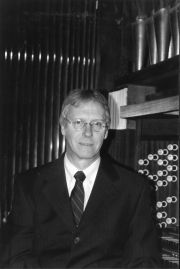 In addition to its place in the convent, the church serves as the local parish church and emotion was visible on the faces of some of the local people attending this long-delayed inauguration as they were treated to a concert by the titular organist, Gilles Desrochers together with the Orchestre de Chambre National de Toulouse conducted by Gérard Caussé. The programme included: three works by Denis Bédard,(1959-) -Suite du Premier Ton pour Orgue; Variations on 'In dulci jubilo' and a Concerto for Organ and Strings; Symphony no. 10 by Mendelssohn; 'Metamorphosis' by Peter Moller (1947 - 1999); Concerto for Organ and Strings in F by Handel and 'Oracion Del Torero' by Joaquin Turina (1882 - 1949).
In addition to its place in the convent, the church serves as the local parish church and emotion was visible on the faces of some of the local people attending this long-delayed inauguration as they were treated to a concert by the titular organist, Gilles Desrochers together with the Orchestre de Chambre National de Toulouse conducted by Gérard Caussé. The programme included: three works by Denis Bédard,(1959-) -Suite du Premier Ton pour Orgue; Variations on 'In dulci jubilo' and a Concerto for Organ and Strings; Symphony no. 10 by Mendelssohn; 'Metamorphosis' by Peter Moller (1947 - 1999); Concerto for Organ and Strings in F by Handel and 'Oracion Del Torero' by Joaquin Turina (1882 - 1949).
The setting, with the chamber orchestra on a platform and the organ in its elevated position in the background, befitted a grand inauguration but engendered a need to produce a programme which, in the event, did not hang together very well. Perhaps this reflects the paucity of works written for organ and other instruments together, which is exacerbated when one wishes to demonstrate the finer points of a particular organ,
The organ is without traditional case and has six visible groups of pipes making an attractive sight. The swell box has glass or perspex shutters which twinkle in artificial light as they are moved. I had the opportunity to play the organ myself the next day and found it a delight to do so.
Sunday 12th
Saint-Etienne - Gillian Weir
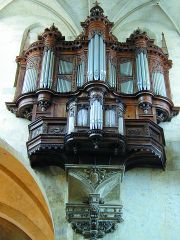 We had a further opportunity to hear Dame Gillian when she gave a recital at Saint-Etienne. On this occasion she gave a concert with the 'Orchestre de Chambre National de Toulouse' with whom she played Samuel Barber's Toccata Festiva and Francis Poulenc's Concerto Pour Orgue. The logistics of performing these works must have caused more than a few headaches with the organist sitting about fifty feet directly above the heads of the orchestra. However, with the aid of closed circuit television and the poor organist and conductor, Gérard Caussé, each being restrained by headphones, both works were performed superbly. Despite the hotch-potch nature of the building, the sound was electrifying.
We had a further opportunity to hear Dame Gillian when she gave a recital at Saint-Etienne. On this occasion she gave a concert with the 'Orchestre de Chambre National de Toulouse' with whom she played Samuel Barber's Toccata Festiva and Francis Poulenc's Concerto Pour Orgue. The logistics of performing these works must have caused more than a few headaches with the organist sitting about fifty feet directly above the heads of the orchestra. However, with the aid of closed circuit television and the poor organist and conductor, Gérard Caussé, each being restrained by headphones, both works were performed superbly. Despite the hotch-potch nature of the building, the sound was electrifying.
The orchestra performed Britten's Simple Symphony and Couperin's 'Les Goûts réunis no 10. From her eyrie somewhere up with the angels, Dame Gillian gave us six extracts from the Magnificat in G minor and Pièces in G major by Jean-François Dandrieu in which she demonstrated some of the beautiful tones of this very French organ - Plein Jeu, Tierce en taille, Muzète, Récit de Nazard, Basse de Cromorne and Dialogue sur les grands jeux. I felt that Dame Gillian had again chosen a programme which was in total harmony with the building and demonstrated yet again, as if it were necessary, what a consummate artist she is.
This is just a sample of some 17 days of Festival. Can you wonder that I am already looking forward to next year?
Raymond Spong
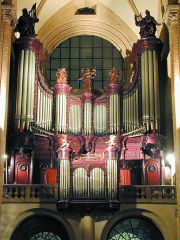

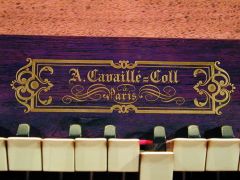
 The village of St Félix de Lauragais stands on a hilltop and is very picturesque. Birthplace of the composer Déodat-de Severac (1872 - 1921), it has a beautiful wooden market hall standing in a square of timber-frame houses. The gothic style church is tucked away among the buildings of the main street.
The village of St Félix de Lauragais stands on a hilltop and is very picturesque. Birthplace of the composer Déodat-de Severac (1872 - 1921), it has a beautiful wooden market hall standing in a square of timber-frame houses. The gothic style church is tucked away among the buildings of the main street. Since it is a German organ, Stéphane Bois (pictured) chose to play Mendelssohn and Reger. The registration used for the first work, Mendelssohn's fourth sonata, sounded very familiar (and non-French) to my ears. After the Mendelssohn, Mr Bois played four pieces by Max Reger, opus 69: Moment musical no. 4, Capriccio, no.5, Romance no.8 and Toccata and fugue no. 7. The registration seemed somewhat dull to me and the pedals hard work.
Since it is a German organ, Stéphane Bois (pictured) chose to play Mendelssohn and Reger. The registration used for the first work, Mendelssohn's fourth sonata, sounded very familiar (and non-French) to my ears. After the Mendelssohn, Mr Bois played four pieces by Max Reger, opus 69: Moment musical no. 4, Capriccio, no.5, Romance no.8 and Toccata and fugue no. 7. The registration seemed somewhat dull to me and the pedals hard work. Warning bells clang whenever someone says 'To be honest with you' and I experienced similar misgivings when the announcer said 'There are a lot of musicologists here and I won't bore you ...' Well, half an hour later we heard the first notes from the organ, Olivier Latry (pictured left) setting off at a cracking good pace, obviously determined to make up lost time. But that wasn't the end of it, there were two further sessions of enlightening explanations about what was to follow before the recital was over.
Warning bells clang whenever someone says 'To be honest with you' and I experienced similar misgivings when the announcer said 'There are a lot of musicologists here and I won't bore you ...' Well, half an hour later we heard the first notes from the organ, Olivier Latry (pictured left) setting off at a cracking good pace, obviously determined to make up lost time. But that wasn't the end of it, there were two further sessions of enlightening explanations about what was to follow before the recital was over.  Ever since I first heard broadcasts and recordings by Gillian Weir playing the organ at Saint Sernin in Toulouse, I have had a strong wish to hear in person her play that particular instrument and particularly to hear her play César Franck, she having said "For César Franck, we may be sure the organ would be the ideal." Happily, my wish was met at this year's festival and this was, for me, a highlight of my visit - César Franck played by such capable hands on this organ in this building.
Ever since I first heard broadcasts and recordings by Gillian Weir playing the organ at Saint Sernin in Toulouse, I have had a strong wish to hear in person her play that particular instrument and particularly to hear her play César Franck, she having said "For César Franck, we may be sure the organ would be the ideal." Happily, my wish was met at this year's festival and this was, for me, a highlight of my visit - César Franck played by such capable hands on this organ in this building. In addition to its place in the convent, the church serves as the local parish church and emotion was visible on the faces of some of the local people attending this long-delayed inauguration as they were treated to a concert by the titular organist, Gilles Desrochers together with the Orchestre de Chambre National de Toulouse conducted by Gérard Caussé. The programme included: three works by Denis Bédard,(1959-) -Suite du Premier Ton pour Orgue; Variations on 'In dulci jubilo' and a Concerto for Organ and Strings; Symphony no. 10 by Mendelssohn; 'Metamorphosis' by Peter Moller (1947 - 1999); Concerto for Organ and Strings in F by Handel and 'Oracion Del Torero' by Joaquin Turina (1882 - 1949).
In addition to its place in the convent, the church serves as the local parish church and emotion was visible on the faces of some of the local people attending this long-delayed inauguration as they were treated to a concert by the titular organist, Gilles Desrochers together with the Orchestre de Chambre National de Toulouse conducted by Gérard Caussé. The programme included: three works by Denis Bédard,(1959-) -Suite du Premier Ton pour Orgue; Variations on 'In dulci jubilo' and a Concerto for Organ and Strings; Symphony no. 10 by Mendelssohn; 'Metamorphosis' by Peter Moller (1947 - 1999); Concerto for Organ and Strings in F by Handel and 'Oracion Del Torero' by Joaquin Turina (1882 - 1949).  We had a further opportunity to hear Dame Gillian when she gave a recital at Saint-Etienne. On this occasion she gave a concert with the 'Orchestre de Chambre National de Toulouse' with whom she played Samuel Barber's Toccata Festiva and Francis Poulenc's Concerto Pour Orgue. The logistics of performing these works must have caused more than a few headaches with the organist sitting about fifty feet directly above the heads of the orchestra. However, with the aid of closed circuit television and the poor organist and conductor, Gérard Caussé, each being restrained by headphones, both works were performed superbly. Despite the hotch-potch nature of the building, the sound was electrifying.
We had a further opportunity to hear Dame Gillian when she gave a recital at Saint-Etienne. On this occasion she gave a concert with the 'Orchestre de Chambre National de Toulouse' with whom she played Samuel Barber's Toccata Festiva and Francis Poulenc's Concerto Pour Orgue. The logistics of performing these works must have caused more than a few headaches with the organist sitting about fifty feet directly above the heads of the orchestra. However, with the aid of closed circuit television and the poor organist and conductor, Gérard Caussé, each being restrained by headphones, both works were performed superbly. Despite the hotch-potch nature of the building, the sound was electrifying.